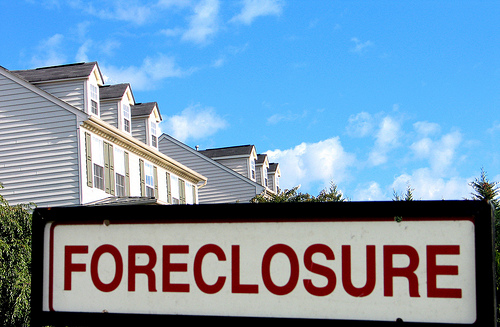
Flickr/<a href="http://www.flickr.com/photos/andrewbain/3899715321/">taberandrew</a>
Was the Obama administration’s $75 billion homeowner rescue program doomed to fail? Is it the federal government’s version of Goldman Sachs‘ now-notorious Abacus deal, the complex financial product Goldman allegedly peddled to customers knowing it was destined to implode? That’s what the Wall Street Journal‘s Evan Newmark asked in a Wednesday column—a question sure to rile up folks at the Treasury and White House. But as someone who’s covered Obama’s housing relief efforts, in particular the flailing Home Affordable Modification Program (HAMP), I think Newmark makes a clever connection here about a program that’s left millions of struggling homeowners out to dry.
Newmark notes that he all but predicted HAMP’s demise back in February 2009, when Obama first unveiled his housing rescue; that from the outset, he knew HAMP wouldn’t at all work. Likewise, a few months into the program, I cited housing experts who’d identified major flaws in the design of the program, which was intended to help millions of homeowners by lowering their monthly mortgage payments and keeping them in their homes. These experts also ripped the Treasury for rushing a program that mortgage servicers—on whom the brunt of the program’s responsibilities fell—were woefully under-equipped and unprepared to handle. The result was long delays, mass confusion, disorganization, and measly success rates. That logjam continues more than a year later, suggesting that HAMP never recovered after stumbling out of the gates. And as I recently wrote, the pace of trial modifications—a test run for homeowners entering the program—is slowing considerably, signaling a slow death for the initiative.
When Obama and Treasury Secretary Tim Geithner rolled out their housing rescue, they claimed it would help between 3 and 4 million homeowners by 2012. Very quickly, it became clear that projection was wildly overblown. By the end of April, a mere 299,092 homeowners, or less than 10 percent of projected homeowners, had begun permanent modifications—the lasting relief promised by the Obama administration. What’s more, the administration arguably backtracked on their initial promise to help 3 to 4 million homeowners modify their mortgage terms by saying they meant 3 to 4 million homeowners would get an offer to modify their loans. Now, the Treasury says the offers were the target from the beginning. But looking back at the promotion and rhetoric surrounding HAMP, that’s certainly not clear. For instance, President Obama said last February that HAMP “will enable as many as 3 to 4 million homeowners to modify the terms of their mortgages to avoid foreclosure.”
What the WSJ’s Newmark also doesn’t mention is that the administration knew the fastest way to fix the foreclosure crisis—but didn’t do anything about it. As the Huffington Post reported in February, a top architect of HAMP, Treasury adviser Seth Wheeler, said his team knew the underlying problem prolonging the foreclosure crisis was negative equity, when a homeowner owes more than their house is worth. (This is called being “underwater.”) “When the administration came into office last year, from the get-go, it has certainly been aware of the link between negative equity and challenges in housing,” Wheeler told HuffPo. The fastest way to help “underwater” homeowners, experts say, is principal reductions—decreasing the total amount homeowners owe and bringing their heads above water. It’s a move that requires banks and investors to take losses, but, housing experts have repeated many times, it’s the best way to end the foreclosure crisis.
Yet, as Wheeler admitted, the Obama administration said, “rather than us endorsing a uniform approach to principal reductions, let’s give flexibility to servicers and hope that they do it on their own in the right circumstances.” In short, they knew principal reductions were key, left the door open for servicers and banks to do them (which they haven’t for obvious reasons—it means less profit for servicers and losses for banks), but didn’t make them do anything. They deferred to the banks.
There you have it. The technocrats in the Treasury and White House created a program with the understanding that it wasn’t the best solution to the problem.
So why did the administration go along with this “mini Abacus” deal? Here’s WSJ’s Newmark:
It’s hard to figure how all the White House PhDs missed this and got their numbers so wrong. Unless of course, they didn’t miss it—but simply judged the HAMP to be politically expedient policy. Not that anyone in Washington ever fesses up to doing that kind of thing.
Meanwhile, the foreclosure crisis continues. Mortgage delinquencies increased in 2010’s first three months, with more than 10 percent of outstanding loans now delinquent. 4.63 percent of mortgages were in the foreclosure process in the first quarter of 2010, a new record. And as a sign of the continuing mess in the housing industry, mortgage fraud was up 400 percent in 2009 from five years earlier, during the subprime bubble.
Yet the administration continues to tout HAMP’s “success.” This fall, we’ll see what people really think of that claim.















